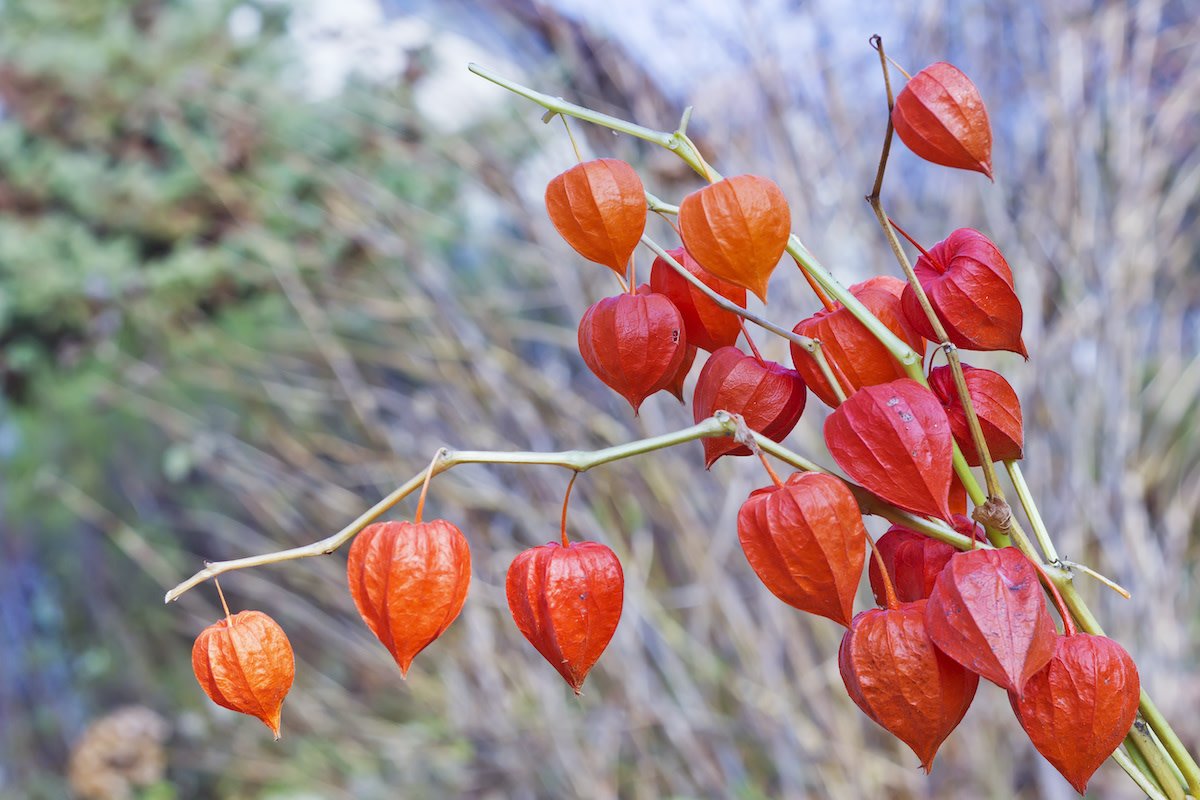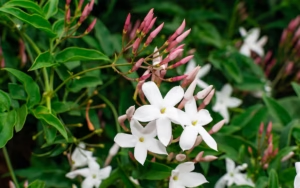The Chinese Lantern plant, known for its vibrant and lantern-shaped orange pods, is a unique and beautiful addition to any garden. Its distinctive appearance and relatively low-maintenance needs make it an appealing choice for gardeners of all skill levels. Whether you’re a seasoned horticulturist or a beginner, understanding how to properly grow and care for the Chinese Lantern plant is crucial to ensuring it thrives. In this blog post, we’ll cover everything you need to know about planting, caring for, and troubleshooting your Chinese Lantern plant.
Quick Reference Table
Before we dive into the details, here’s a quick reference table for the Chinese Lantern plant:
| Common Name | Chinese Lantern Plant |
|---|---|
| Botanical Name | Physalis alkekengi |
| Family | Solanaceae |
| Plant Type | Perennial |
| Mature Size | 18-30 inches (45-75 cm) tall, 12-18 inches (30-45 cm) wide |
| Sun Exposure | Full sun to partial shade |
| Soil Type | Well-drained, loamy soil |
| Soil pH | Slightly acidic to neutral (6.0 – 7.0) |
| Hardiness Zones | 3-9 (USDA) |
| Native Area | Asia, Europe |
| Toxicity | Toxic if ingested (berries and leaves) |
Planting and Transplanting Chinese Lantern Plant
Planting the Chinese Lantern plant is a straightforward process, but it requires some attention to detail to ensure it flourishes. These plants are quite resilient, but choosing the right location and planting technique can make a huge difference in how well they grow.
Choosing the Right Location
The Chinese Lantern plant prefers full sun but can tolerate partial shade, making it versatile for different garden types. However, the more sunlight it receives, the better the chances for vibrant blooms and healthy growth. Choose a spot in your garden that gets at least six hours of direct sunlight each day.
Soil Preparation
Chinese Lantern plants thrive in well-drained, loamy soil. They prefer slightly acidic to neutral soil with a pH between 6.0 and 7.0. Before planting, ensure the soil is loose and well-aerated. If your garden soil is heavy or clay-like, you can improve drainage by mixing in compost or sand.
Planting Technique
If you’re starting from seeds, sow them indoors about 8-10 weeks before the last frost date in your region. Once the seedlings are large enough and the danger of frost has passed, transplant them outside. Dig a hole that is large enough to accommodate the root ball and gently place the plant inside. Make sure the soil level in the pot matches the surrounding soil level to avoid stress on the roots.
Transplanting
If you’re transplanting an established plant, choose a time in early spring or fall. Carefully dig up the plant, keeping as much of the root system intact as possible. Replant it in the desired location, and water thoroughly to help the plant settle in. Ensure it has adequate space to grow, as the plant can spread quite wide.
Chinese Lantern Plant Care
Taking proper care of your Chinese Lantern plant ensures that it remains healthy, strong, and vibrant. While it is relatively low-maintenance, there are a few key care practices that can help optimize its growth.
Watering
Chinese Lantern plants prefer consistently moist soil but can’t tolerate standing water. It’s important to water deeply but infrequently, allowing the top layer of soil to dry out before watering again. Overwatering can lead to root rot, so ensure the soil has good drainage.
Fertilizing
Although the Chinese Lantern plant isn’t a heavy feeder, applying a balanced fertilizer once or twice a season can help encourage healthy growth and blooming. You can use a slow-release granular fertilizer or a water-soluble fertilizer, depending on your preference.
Mulching
Applying mulch around the base of the plant can help retain moisture, regulate soil temperature, and suppress weeds. Organic mulch, such as shredded bark or compost, works well for Chinese Lantern plants. Be sure to keep the mulch layer about 2-3 inches thick, and avoid piling it against the plant’s stem to prevent rot.
Types of Chinese Lantern Plant
There are a few varieties of the Chinese Lantern plant, each with slight differences in appearance and growth habits. Here’s a look at the most common types.
Physalis alkekengi (Common Chinese Lantern)
This is the most commonly grown variety, known for its iconic bright orange, lantern-like calyx. It grows well in a variety of climates and is easy to cultivate.
Physalis alkekengi ‘Franchetii’ (Franchet’s Chinese Lantern)
This variety is slightly less common but has a similar appearance. It produces smaller, more delicate lantern-shaped calyces in a light orange hue. It’s known for being somewhat less aggressive than the common variety.
Physalis peruviana (Cape Gooseberry)
While not exactly the same as the traditional Chinese Lantern plant, the Cape Gooseberry (also known as Goldenberry) belongs to the same genus and is sometimes confused with Physalis alkekengi. This variety produces edible fruit inside its papery lanterns.
Pruning
Pruning your Chinese Lantern plant helps maintain its shape, encourages better airflow, and improves its overall health. This plant can spread quickly, and regular pruning will prevent it from becoming too unruly.
When to Prune
The best time to prune your Chinese Lantern plant is in early spring, just as new growth begins. You can also prune in late fall after the plant has finished blooming and has started to die back. Cutting back the plant at this time can help prepare it for the winter months.
How to Prune
Start by removing any dead or diseased branches. You can also trim back any overgrown or leggy growth to help the plant maintain a neat, compact shape. If you want to control the spread of the plant, remove any side shoots or runners that are extending beyond the desired area.
Post-Bloom Pruning
After the plant has bloomed and the lanterns have formed, you can trim back the foliage and stems to allow the plant to conserve energy for the winter months. This will help it come back strong the following year.
Propagating Chinese Lantern Plant
Propagating the Chinese Lantern plant is relatively simple and can be done through division or stem cuttings.
By Division
In early spring or fall, carefully dig up the plant and divide the root ball into smaller sections. Each section should have a portion of the root system attached. Replant these divisions in their new spots, ensuring they are well-watered and given plenty of sunlight.
By Stem Cuttings
Take a healthy stem cutting in the spring or early summer. Ensure the cutting is about 4-6 inches long and includes a few nodes. Remove the lower leaves and dip the cut end in rooting hormone. Place the cutting in a small pot filled with moist potting mix and cover it with a plastic bag to retain humidity. Once roots develop, transplant the cutting into the garden or a larger container.
Potting and Repotting Chinese Lantern Plant
While Chinese Lantern plants are typically grown in the ground, they can also thrive in containers. Potting and repotting are essential for container-grown plants to ensure they have enough space for growth.
Choosing the Right Pot
Select a pot with drainage holes to prevent waterlogging. The pot should be large enough to accommodate the plant’s root system and allow for future growth. A 12-inch pot is usually suitable for a single Chinese Lantern plant.
Repotting
Repotting should be done every two to three years or when the plant becomes root-bound. To repot, carefully remove the plant from its current container, loosen the roots, and place it in a new pot with fresh potting mix. Water the plant thoroughly after repotting and place it in a location with plenty of sunlight.
Overwintering
In colder climates, Chinese Lantern plants are not frost-tolerant and need protection during the winter months. Here’s how to ensure your plant survives the cold weather.
Winterizing Outdoor Plants
In USDA zones 3-5, it’s essential to cut the plant back to the ground before the first frost. Apply a thick layer of mulch (about 4-6 inches) over the root zone to insulate the plant from the cold. You can also cover the plant with burlap or frost cloth for additional protection.
Indoor Winter Care
If you live in a colder climate, you can dig up your Chinese Lantern plant and bring it indoors for the winter. Place it in a pot and keep it in a cool, sunny spot. Water sparingly during the winter months, as the plant will be in a dormant state.
Common Problems with Chinese Lantern Plant
Chinese Lantern plants are generally easy to grow, but like all plants, they can face a few issues. Here are some common problems you might encounter.
Root Rot
Root rot is typically caused by overwatering or poor drainage. If you notice wilting leaves or a musty smell around the plant’s base, root rot may be the culprit. Ensure the soil is well-draining and allow it to dry out between waterings.
Leggy Growth
If your Chinese Lantern plant isn’t getting enough sunlight, it may become leggy with long, weak stems. Ensure the plant is getting at least six hours of direct sunlight each day to promote healthy growth.
Common Pests & Plant Diseases
While the Chinese Lantern plant is relatively resistant to pests and diseases, it’s not immune. Here are a few common issues you may encounter:
Aphids
Aphids are small, green or black insects that suck the sap from the plant. They can cause distorted leaves and stunted growth. To manage aphids, spray the plant with insecticidal soap or a mixture of water and dish soap.
Powdery Mildew
Powdery mildew is a fungal disease that appears as a white, powdery coating on the leaves. To prevent this, ensure the plant has good airflow and avoid overhead watering. If you notice mildew, prune affected leaves and treat the plant with a fungicide.
How to Get Chinese Lantern Plant to Bloom
Chinese Lantern plants are known for their distinctive orange lantern-shaped calyces. To encourage blooming, follow these tips:
Ensure Proper Sunlight
For the best blooms, your plant needs plenty of sunlight. If it’s not blooming, it could be because it’s not getting enough light. Ensure it’s planted in a location with full sun exposure.
Avoid Overwatering
Overwatering can lead to poor bloom production. Make sure the soil drains well and the plant doesn’t sit in water for too long.
FAQ
1. Is the Chinese Lantern plant edible?
While the plant produces small berries inside its lanterns, they are toxic when eaten raw. They can cause stomach upset and other health issues. Always avoid eating any part of the plant.
2. Can I grow Chinese Lantern plants in pots?
Yes, Chinese Lantern plants can grow well in pots, as long as they are given plenty of space and proper care. Be sure to use a pot with good drainage.
3. How do I stop my Chinese Lantern plant from spreading?
Chinese Lantern plants can spread aggressively. To control its spread, prune back runners and divide the plant every few years to keep it contained.
4. Is the Chinese Lantern plant poisonous to pets?
Yes, the Chinese Lantern plant is toxic to pets. Keep it out of reach of animals, especially if you have curious cats or dogs that might nibble on the leaves or fruit.
Read also: Complete Guide on Growing and Caring for Philodendron Brasil










